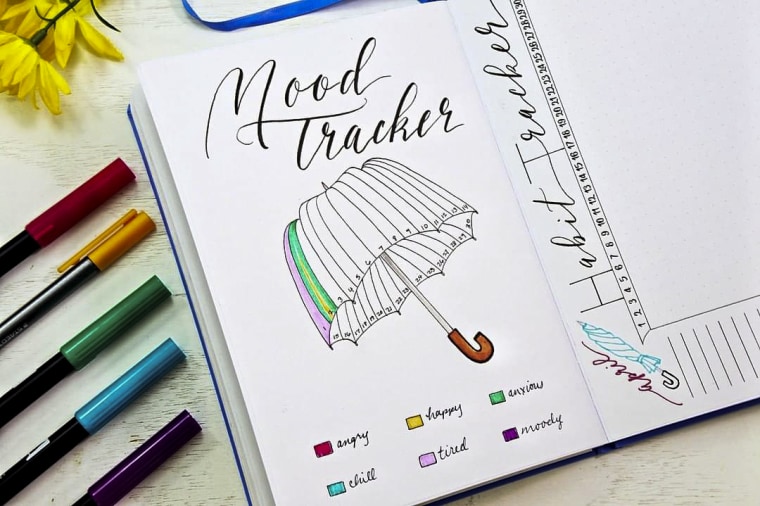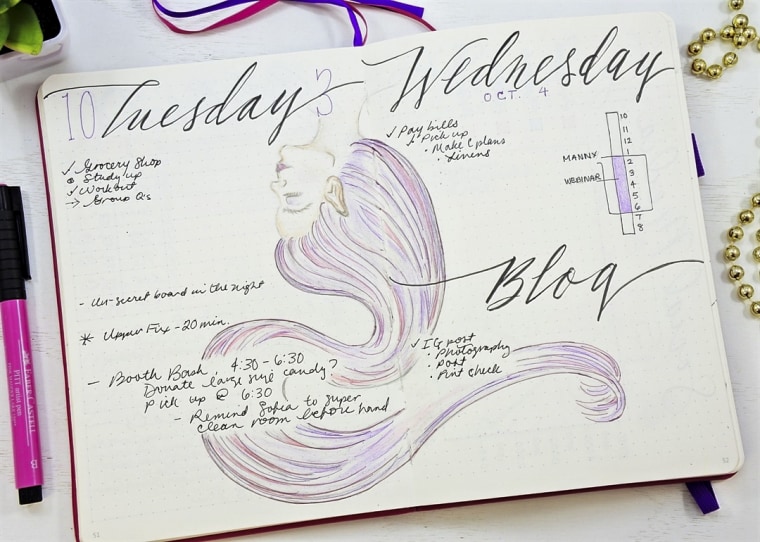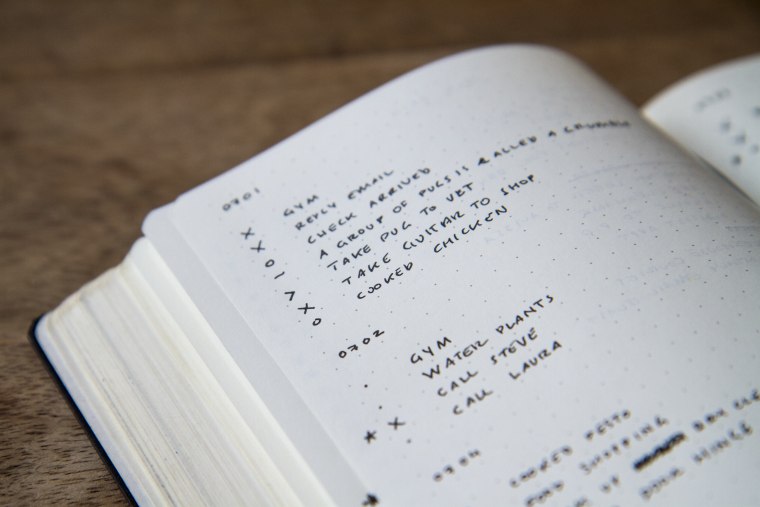If you’ve scrolled through Instagram or Pinterest recently, you’ve likely spotted images of beautifully-decorated journals, dotted with symbols, lists and imaginative artwork. While certainly eye-catching, perhaps you’ve never truly considered the purpose behind these pages.
Called “bullet journals,” these notebooks are a way to track daily and monthly tasks along with long-term goals.
Founded by Ryder Carroll, the bullet journal is “a methodology that happens to use notebooks.”
"Notebooks are for 'BuJo' what yoga mats are to yoga. Bullet journaling is a mindfulness practice designed like a productivity system. It helps you organize what you’re doing while keeping you mindful of why you’re doing it," he tells TODAY.com.
Since many of us have such jam-packed days, incorporating mindfulness into everyday organization is a solid approach. For Carroll, it helps him stay more focused, which is why he created the concept in the first place.
“'BuJo' is a collection of solutions to problems I faced growing up with learning disabilities,” he says. “Back then, the goal was to figure out ways to become more focused and productive. I tried countless approaches, most of which didn’t work. Every once in a while, something would. Then another. Over the years, these tools came together into a method that allowed me to accomplish pretty much whatever I focused on.”
But isn’t a bullet journal just a fancier planner? While you may be thinking this, there are key differences between the two.
Sheena Landrum, Pinterest manager and blogger at Sheena of the Journal, says that with a standard planner, you can only record and keep track of the things the planner already has sections for. Since everyone’s needs are different, a bullet journal can be “anything and everything you want it to be."
Unlike a basic planner, a bullet journal provides a line of sight into the entire month and year, which can allow you to prioritize and cross out things that didn’t turn out to be as important as you thought.
Carroll estimates that one million people worldwide bullet journal. "There has been an uptick in bullet journaling, especially during the pandemic,” he says. “I think it’s been a season for real soul searching, and there are few better tools for that than pen and paper.”

How to bullet journal
It's easy to get started bullet journaling, but it does require some commitment.
Carroll recommends beginning with the free tutorials, like the ones on his website. “You can learn the basics in under five minutes,” he says, adding that you should plan to give it at least two months for it to become part of your regular routine.
While some bullet journals are decidedly straightforward, others can be quite artistic and ornate. “You don’t need to be an artist to BuJo — all you need is an intention. Knowing what you want to get out of your practice is key in making it work," Carroll adds.
When's a good time to start? “Always now,” Carroll quips. Start with the month in front of you, then map out the next month. When you’ve got the hang of it , you can start it a day or two before the beginning of the month.
Carroll's best piece of advice: "Keep it simple and be patient with yourself. Approach your practice with curiosity instead of judgement.”

When you're ready to get started on your BuJo journey, follow the steps below.
1. Pick out a notebook and gather supplies
While many BuJo devotees recommend a dot-grid notebook with a lay-flat spine and numbered pages, you can certainly choose any notebook that you prefer, as both of our experts suggest.
“Pick out a notebook: any notebook,” Landrum tells TODAY.com. "The only requirement is that you love it.”
As for supplies, Landrum says that if you’re a minimalist, you’ll really only need a notebook and pen, preferably one that doesn’t bleed. But if you’re a creative type, Landrum recommends gathering colorful pens, stickers, and a brush pen "if you want to try your hand at some fancy headers."
2. Focus on a goal
Many people turn to bullet journaling to keep tabs on meetings, events and other daily goals. But it can be used to fulfill meaningful, long-term goals as well.
"You can start simple with an intention like: I want to be more productive or I want to be a more attentive parent or I want to do better in school. Your intention will be what powers your practice," Carroll says. This can also help you determine the problem you’re trying to solve, which will help you pick the right tools for the job.
“Some people use their bullet journal specifically to meal plan and track their diet and weight loss goals. Others use it for managing their mental health by journaling and keeping track of their moods, habits and triggers," Landrum says.
"The beauty of starting a bullet journal is that you have complete control over its contents — whatever it is you’re trying to manage in your life, your bullet journal is there to help.”
3. Learn the terminology and get organized
Another difference between a standard planner or a basic notebook? Bullet journals come with terminology so you can stay on top of your organization game.
Carroll created a “How to Bullet Journal” video that has become a holy grail of sorts for bullet journal beginners (it’s been viewed over 14 million times). If you’re a visual learner, it’s very helpful and outlines the standard steps of starting a bullet journal, which include:
- Devote the first blank spread to the Index, which is where you’ll keep track of page numbers to look up.
- The next blank spread will be your Future Log. Write the words “Future Log” at the top of each page, or you can purchase a premade bullet journal that has these pages already marked. To do it yourself, count the number of lines on the pages and divide that number by three. Use a ruler to cleanly draw two lines across the spread, and add the months of the year to each box that you’ve created. “I create a future log for the next six months to a year in every bullet journal I start. Not only does it keep you more organized, but it’s a great way to see an overview of your year and plan accordingly," Landrum says.
- Then there's the Monthly Log. For this, you’ll write the month on top of both pages. In the left margin of the spread, write all the dates of the month, and next to those, write the first letters of each corresponding day of the week. The right page will serve as a monthly task list, where you’ll write down all the things you need to accomplish during the month. Each task will have a bullet, which is a dot. You can write down the page numbers and add them to your Index.
- Next, you’ll create a Daily Log. This will come after your Monthly Log. Devote each page to a day and add tasks as you go.

BuJo devotees re very familiar with the symbols associated with bullet journaling. Created by Carroll, they denote various types of tasks, events and thoughts:
- Tasks: •
- Events: O
- Notes (any observations or good-to-know pieces of info): —
- High Priority: *
“The bullet journal system involves using a specific key so you can see at a glance what your tasks are and easily plan for the future without anything slipping through the cracks,” Landrum says.

4. Let go of perfection
While you can certainly get inspired by the photos you see all over social media, Landrum says it's important to remember that you don’t have to be a great artist, calligrapher or even a particularly productive person to have a great bullet journal and benefit from the experience.









